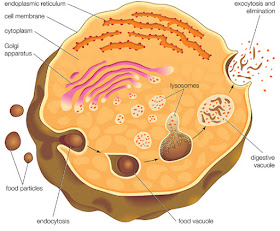 |
| Endocytosis and Exocytosis |
Endocytosis is used by cells to move water, macro molecules, or larger objects, such as cell fragments or even whole cells, from outside a cell to the inside of the cell. Exocytosis is the reverse of endocytosis, that is, the movement of materials from the inside to the outside of the cell. Both types of transport move the materials using membrane-bound vesicles.
Endocytosis
In endocytosis, during which materials are moved into a cell, the cell’s plasma membrane engulfs material and packs it into saclike structures called vesicles. The vesicles then detach from the plasma membrane and move into the cell.
Once the vesicle is in the cytoplasm, it will typically fuse with some other membrane-bound organelle, such as a vacuole or the endoplasmic reticulum, and release its contents into the organelle. There are three types of endocytosis: phagocytosis (transport of actual particles), pinocytosis (transport of water, along with any solutes in the water), and receptor-mediated endocytosis (explained in detail below).
  |
In receptor-mediated endocytosis, specific macro molecules outside the cell attach to the binding sites of receptor proteins. These receptors are embedded in the plasma membrane in specialized regions called coated pits. The macromolecules contact and bind with receptor proteins in the pit.
The coated pit deepens inward to the cytosol and eventually is pinched off as a coated vesicle inside the cell. Coated vesicles contain the receptor proteins and whatever molecules they are importing and are coated on the outside by a protein called clathrin.
After the contents of the vesicle are released inside the cell, the receptor proteins are reused to form new coated pits. Receptor-mediated endocytosis is especially useful for importing specific molecules, even when they are present at low concentrations.
 |
| endocytosis |
Endocytosis is more difficult in plants than in animals because the plasma membrane of a plant cell is usually pressed against the rigid cell wall by turgor pressure, which hinders the plasma membrane from invaginating into the cytosol.
Nevertheless, plant cells do have coated pits, and experiments with isolated protoplasts (plant cells without their cell walls) suggest that receptor-mediated endocytosis works in plant cells much as it does in animal cells.
In a special form of phagocytosis, symbiotic nitrogen-fixing bacteria (rhizobia) colonize root cells in legumes. First, root hairs surround rhizobia cells in a ball-like mass. Next, infection threads, composed of an extended portion of the cell membranes of the cell being invaded, are formed.
The bacteria multiply inside the thread, which extends inwardly and penetrates through and between cortex cells. In the inner cortex cells, portions of the thread wrap around groups of bacteria in vesicles, which pinch off into the cytosol. A membrane which forms around a group of bacteria is called a bacteroid.
Exocytosis
 |
| Exocytosis |
Some vesicles contain structural proteins and polysaccharides, whereas other vesicles, such as vacuoles, contain digestive enzymes. Each vesicle attaches to the plasma membrane. The site where it attaches opens, and the materials in the vesicle are dumped out of the cell. The vacated vesicle straightens and becomes a part of the plasma membrane.
A problem arises if vesicles continually fuse with the plasma membrane, because large amounts of new membrane being added can double the amount of plasma membrane every thirty minutes, and the plasma membrane has little room to expand in cells with rigid cell walls. Nevertheless, plants cells regularly recycle excess plasma membrane via endocytosis.
Roles of Endocytosis and Exocytosis
Both exocytosis and endocytosis occur within seeds. Starch-digesting enzymes, such as alpha-amylase, move from cell to cell in cereal grains. In the cells of the aleurone layer, the endoplasmic reticulum manufactures these enzymes and packs them into vesicles. The enzymes are exuded from vesicles by exocytosis through the plasma membrane and must then be transported into the cells of the endosperm by endocytosis.
   |
Inside the endosperm cells, the enzyme-containing vesicle fuses with an amyloplast, a plastid specialized for storage of starch, where the enzymes hydrolyze starch into glucose.
Exocytosis of macromolecules plays other important roles in plants. For example, polysaccharides and proteins that are exported become structural components of cell walls.
After cell division, exocytosis by secretory vesicles builds primary cell walls between newly divided nuclei. Epidermal cells of leaves extrude waxy substances onto leaf surfaces to minimize transpiration. Root-tip cells exude slimy polysaccharides to lubricate their movement as they grow and penetrate the soil.
Exocytosis of other substances by specialized cells also plays many roles in plants. For example, exocytosis is involved in the secretion of nectar by flower cells to attract pollinators. Exocytosis is also the process whereby oils are emitted by aromatic flowers, herbs, and spices. Such oils function both as attractants for pollinators and as defenses.
 |
| Roles of Endocytosis and Exocytosis |
For example, oils emitted by mustard plants irritate many animals, thus preventing many herbivores from eating them. Lignin, which is more rigid than cellulose and strengthens woody tissue, is expelled via exocytosis in woody plants and then accumulates in the middle lamella and cell walls.
Enzymes that digest insects are released by the leaf cells of carnivorous plants, such as Venus’s flytrap. Root exudates are released by some plants in response to environmental stress or to deter the growth of other plant species nearby.
Phytoremediation
Phytoremediation uses plant roots to clean polluted soil and water. They can remove, by endocytosis, and degrade both small organic molecular pollutants (ammunition wastes, chlorinated solvents, and herbicides) and large organic molecular pollutants (crude oil and polyaromatic hydrocarbons) in the environment. The degraded products can then be incorporated in the plant’s tissues.